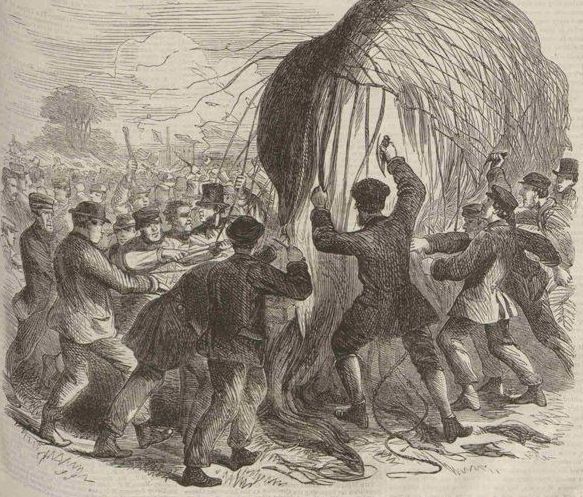During the latter part of the 18th century and most of the 19th century, there was a notable surge in public fascination with ballooning. This interest was sparked by the inaugural flights conducted by the Montgolfier brothers in 1783, closely followed by the hydrogen balloon journeys orchestrated by Jacques Alexandre César Charles. This trend swiftly gained popularity in both France and England, drawing crowds ranging from hundreds to thousands of eager spectators who would eagerly gather for balloon launches. In some instances, the level of enthusiasm reached such heights that there were threats of rioting if the launches faced any delays. One such unfortunate incident transpired during a demonstration by British aeronaut Henry Tracey Coxwell.

James Glaisher (left) and Henry Tracey Coxwell ballooning in 1864.
Henry Tracey Coxwell was a pioneering English aeronaut whose historic flight in 1862 with meteorologist James Glaisher made his something of a celebrity. Coxwell and Glaisher had soared to the stratosphere in a hot air balloon reaching an altitude of 35,000 feet. In the thin, oxygen-deficit atmosphere, Glaisher had passed out and Coxwell lost all sensation in his hands. With his hands useless, Coxwell had to use his teeth to work the valves which released gas allowing the balloon to descend to a safer altitude.
Two years later, Coxwell constructed a new balloon which he named Britannia, and made some preliminary tests at Crystal Palace and Derby, following which he decided to make a demonstration on 11 July 1864 at the racecourse at Victoria Park, Leicester during a fete organized by the Foresters Friendly Society.
On the day of the flight, a crowd of about 50,000 people gathered on the racecourse. As preparations for the ascent were underway a rumor circulated that the balloon on display was not Coxwell's newest and biggest balloon but an older model. The mood of the crowd turned ugly, and a section of it broke through the barrier and demanded that Coxwell take off immediately.

Henry Tracey Coxwell
Coxwell had announced that he was taking about a dozen passengers with him on the flight and had sold tickets accordingly. These passengers now forced their way into the balloon basket in such a manner that Coxwell had to stop all operations. This angered the crowds further because they now believed that Coxwell had no intention to ascend. In an effort to control the mob, the police were forced to raise their sticks and a female member of the crowd got hurt. As she fell to the ground bleeding, it caused further anger in the crowd.
During the disturbance, one of the agitators hurled a bottle into the balloon, causing damage to the envelope, while others forcibly tore apart the enclosing mesh. In response, Coxwell issued a warning that unless order was restored and the crowd retreated, he would release the gas from the balloon. However, his admonition was met with only verbal abuse, prompting Coxwell to carry out his threat. As the envelope deflated, the crowd surged forward and ripped it into pieces. Subsequently, they set fire to the basket, reducing it to ashes. Coxwell himself was attacked and his clothes torn from his body. He ran for safety and found refuge at the house of the town clerk.

A depiction of the riot from the Penny Illustrated Paper.
Coxwell laid the blame for the riot with the Leicester City Police, who he said had failed to provide a sufficient number of officers. The London Review of Politics, Society, Literature, Art and Science described the crowd as “a horde of savages as fierce and untamed as South Sea Islanders and differing very little from them except in their habitat, which was at Leicester.”
“It is humiliating to think,” the author continued, “that after all the civilising influences which have been exerted upon them, so much of the savage should still linger in the blood of our working classes.”
Leicester residents blamed for the disturbance on out-of-towners, but the damage was done. The satirical magazine Punch called Leicester residents “Balloonatics”, and the term stayed for some time.












Comments
Post a Comment